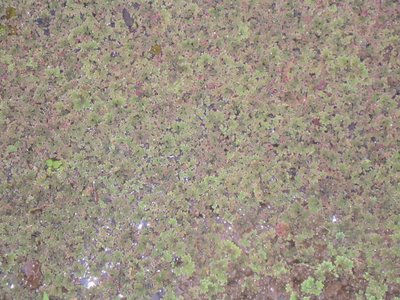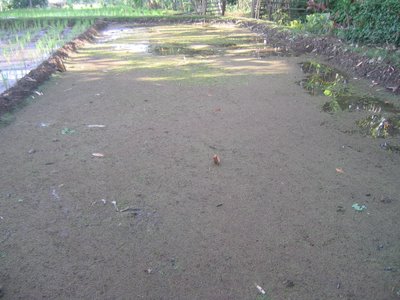
Azolla atau yang lebih dikenal di Jawa Barat dengan nama Kayambang. Kolam ini khusus dibuat untuk perbanyakan azolla, ini adalah pabrik pupuk nitrogen alami.

Berikut artikel mengenai Azolla (bhs Inggris : Mosquito ferns) dari Wikipedia :
The Mosquito ferns, genus Azolla, also called water ferns and duckweed ferns because they are often found growing alongside with duckweed species, are a peculiar genus (the only genus in the family Azollaceae) of six species of aquatic ferns. They are extremely reduced in form and specialized, looking nothing like conventional ferns but greatly resembling moss.
Mosquito ferns float on the surface of water with their roots floating in the water. They form a symbiotic relationship with the cyanobacterium Anabaena azollae, which allows the plants to fix nitrogen from the air.
Because of their nitrogen-fixing capability, mosquito ferns have enabled an agricultural revolution in parts of southeast Asia. When rice paddies are flooded in the spring, they can be inoculated with Azolla, which then quickly multiplies to cover the water. As the plants die, they contribute nitrogen to the rice plants, and as the rice paddy dries out, the Azolla all eventually die, making an exceptional green fertilizer.
Mosquito ferns, however, are also serious weeds in many parts of the world, covering bodies of water so thickly that no water is exposed. This is where they derive their common name, from the belief that no mosquito can penetrate the coating of fern to lay its eggs in the water. Azolla is reputed to be able to grow so quickly that it can double its mass in three days under good conditions.
Most of the species can produce large amounts of anthocyanins in bright sunlight, creating an intense red color and causing the water surface to appear to be covered with a red carpet.
Mosquito ferns are safe to grow in cool temperate areas with prolonged freezing in winter, as they cannot overwinter in these conditions. They are often grown as an ornamental plant by water-garden hobbyists.
Reproduction
Azolla can reproduce asexualy by breaking off. Each branch that breaks off forms a new plant.
Azolla can also reproduce sexually. Like all ferns, Azolla produce spores. Unlike most ferns, Azolla produces two kinds of spores. During the summer months, numerous spherical structures called sporocarps form on the undersides of the branches. The male sporocarp is greenish or reddish and looks like the egg mass of an insect or spider. It is two millimeters in diameter, and inside are numerous male sporangia. Male spores (microspores) are extremely small and are produced inside each microsporangium. One very curious thing about microspores is that they tend to stick together in little clumps or masses called massulae.
Female sporocarps are much smaller, and only contain one sporangium and one functional spore. Since an individual female spore is considerably larger than a male spore, it is termed a megaspore.
Azolla has microscopic male and female gametophytes that develop inside the male and female spores. The female gametophyte protrudes from the megaspore and bears one to several archegonia, each containing a single egg. According to Scagel, et al. (An Evolutionary Survey of the Plant Kingdom, 1966), the microspore forms a male gametophyte with a single antheridium which produces eight swimming sperm. The barbed glochidia on the male spore clusters presumably cause them to cling to the female megaspores, thus facilitating fertilization.
2 comments:
saya, baru saja akan mengembangkan penanaman padi organik.
namun aplikasinya serasa bingung, namun saya akan terus maju.
di beberapa artikel, termasuk di blog ini dibahas kunggulan azolla pinata, namun saya tidak kenal dengan tanaman ini, dapatkan saya memperoleh saple / benih tanaman ini. saya siap berkunjung ke lokasi anda. di gasol cugenang cianjur.
terima kasih
maaf satu pertanyaan lagi
apakah sama antara azolla pinata dan kayambang?
di beberapa artikel disebutkan bahwa kayambang itu sama dengan Salvinia molesta, sedangkan azolla sejenis pakis air. dan dalam gambar secara fisik sangat berbeda?
terima kasih
Post a Comment